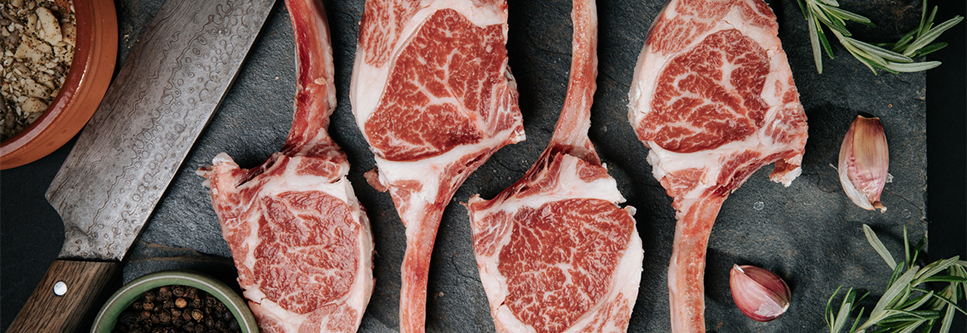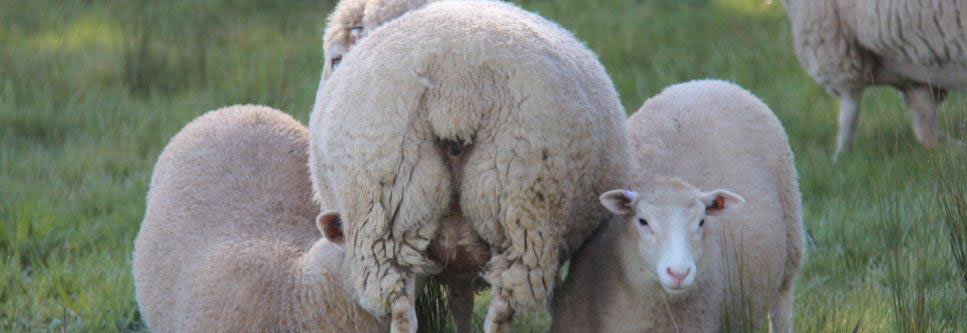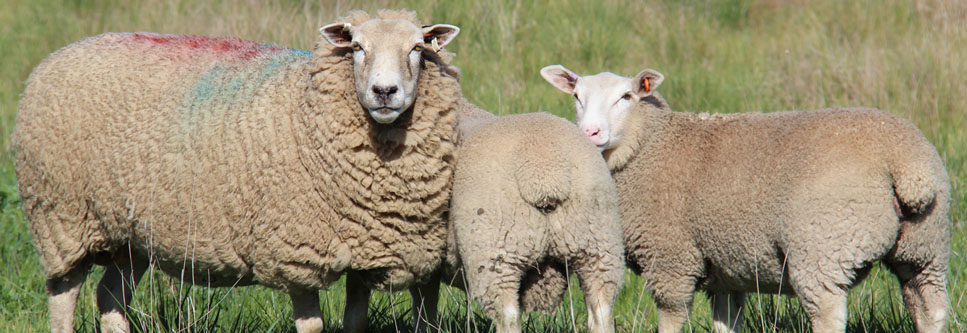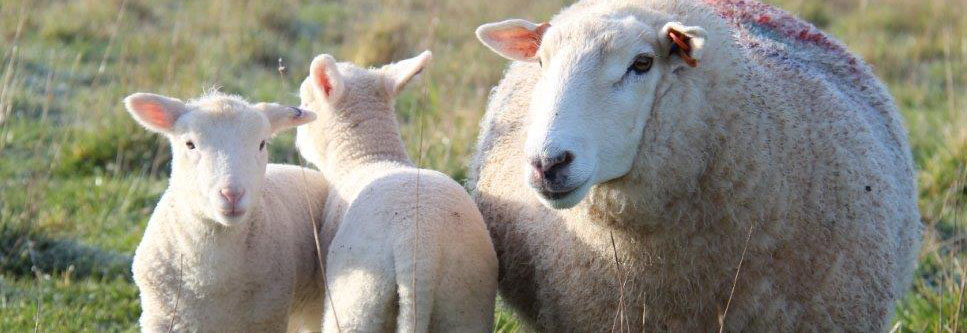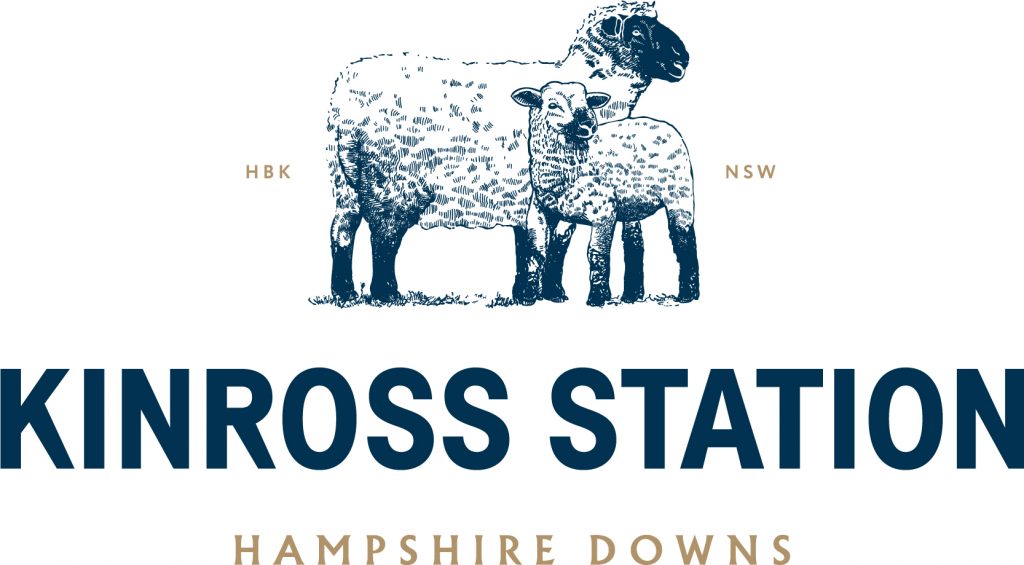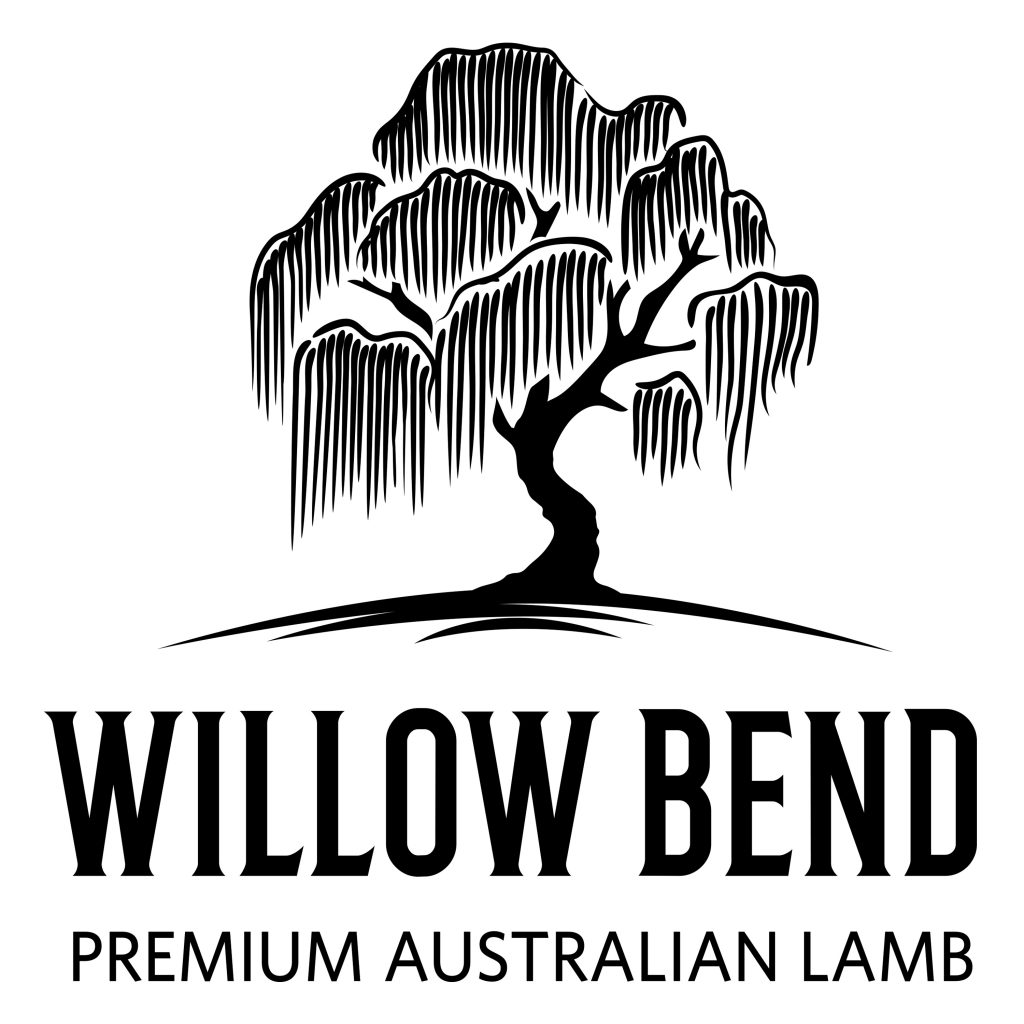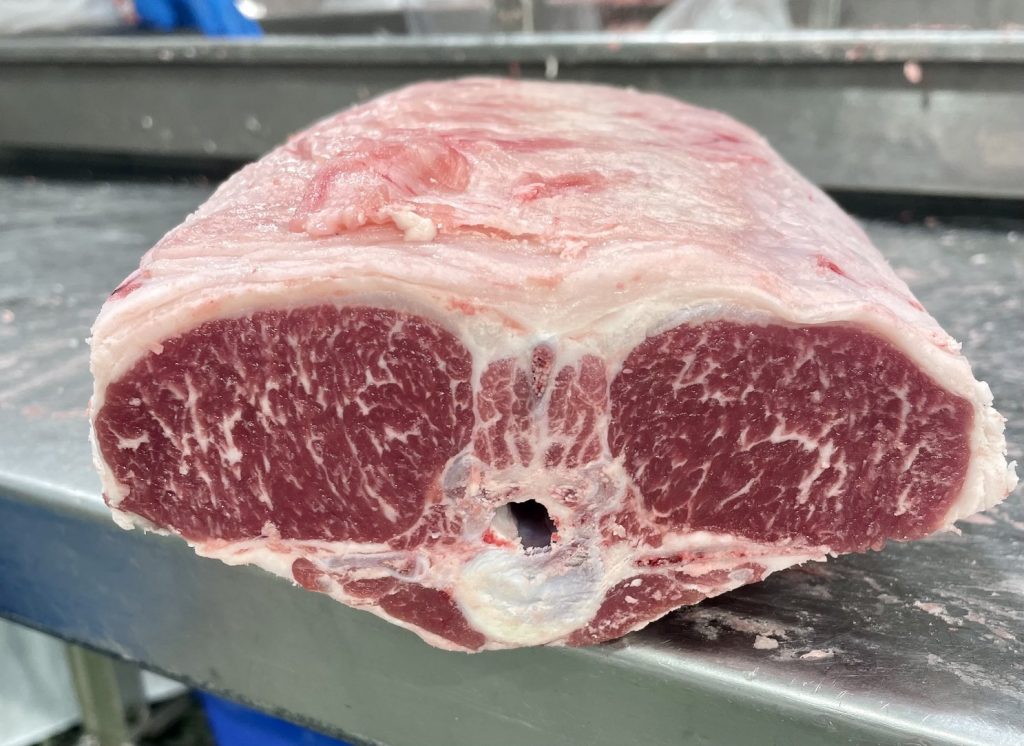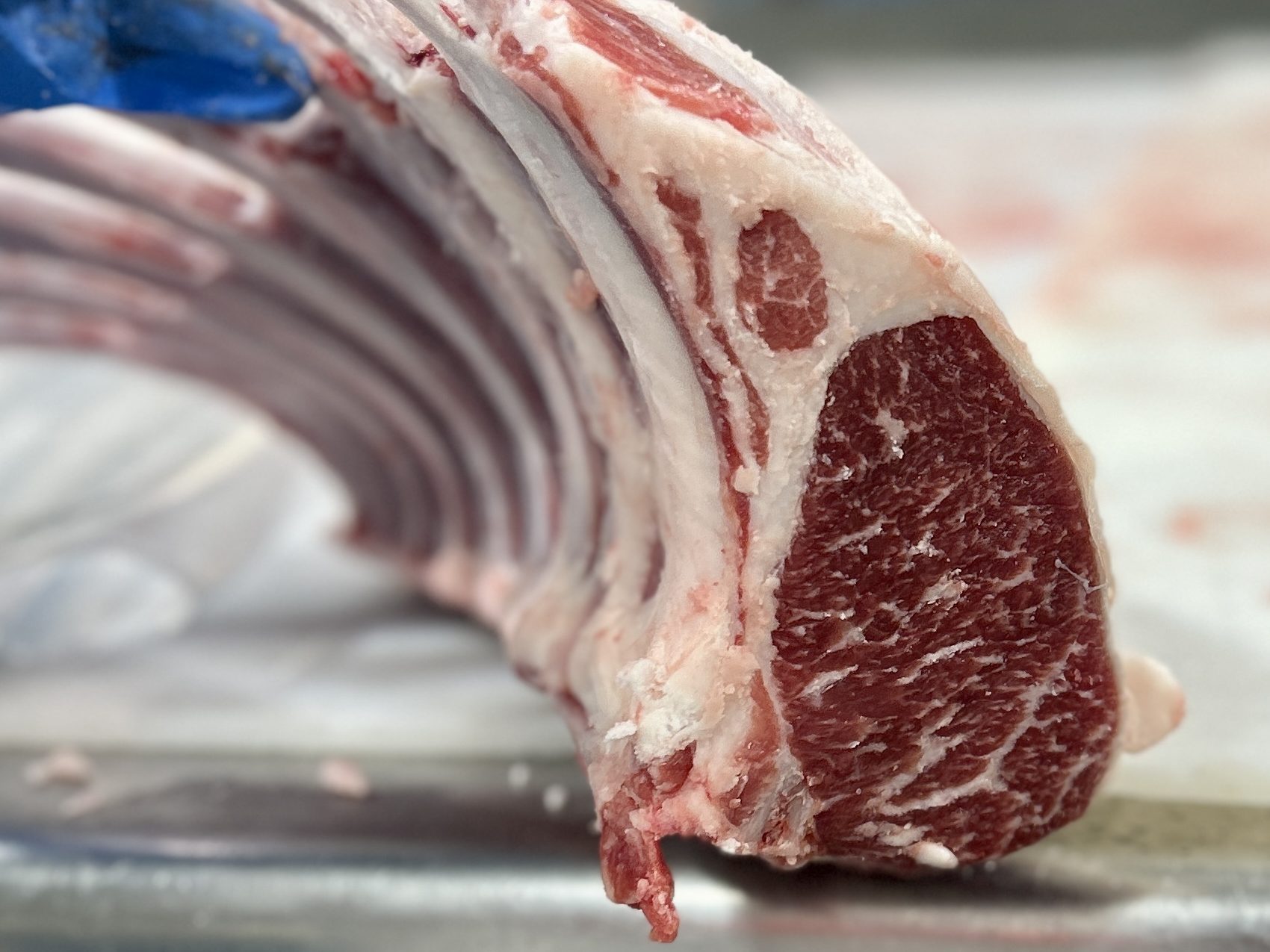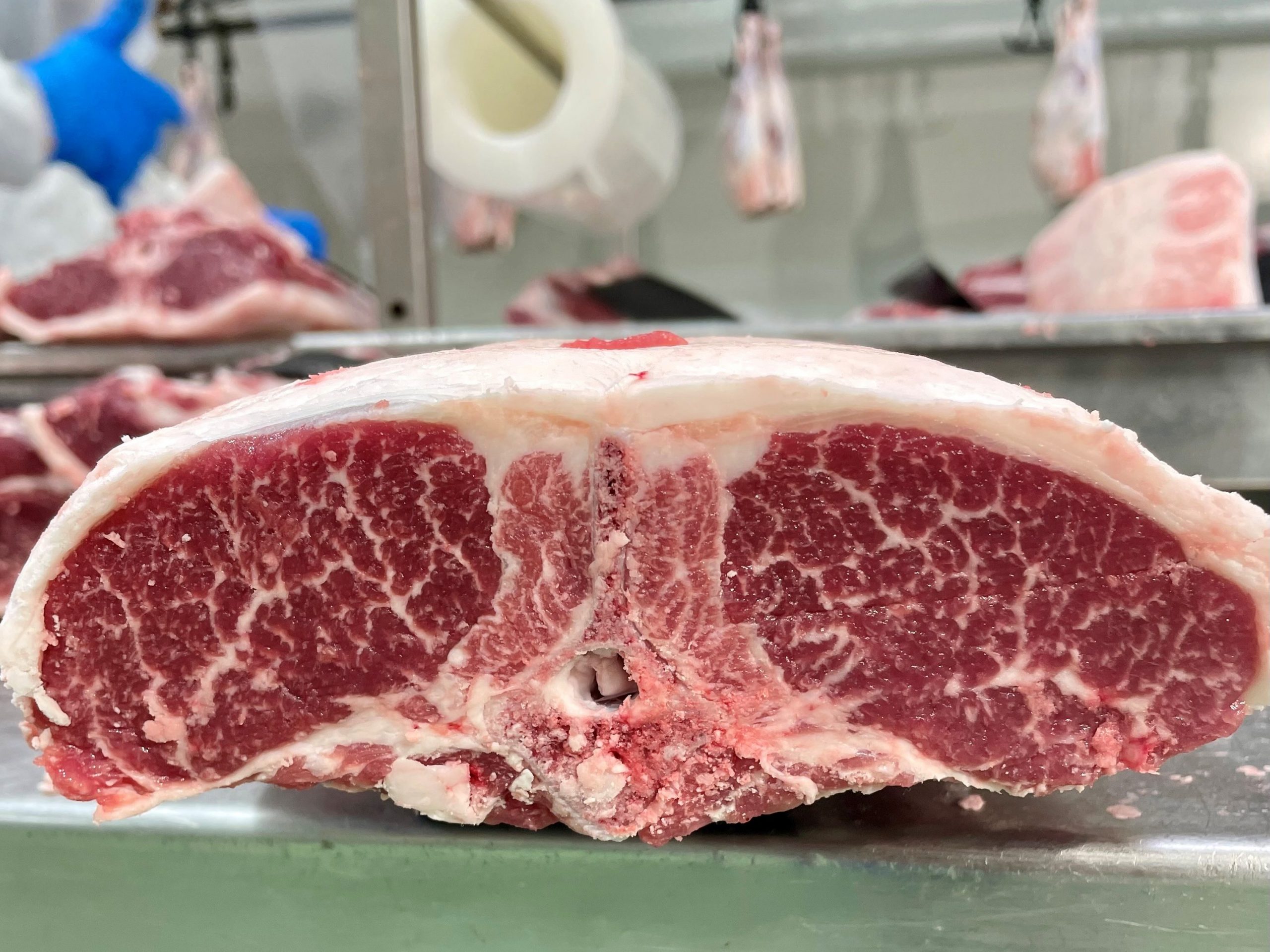Marbling
Could marbling be one of the biggest opportunities to reduce cost of production in lamb?
One of the biggest differences between beef and lamb systems is the low percentage of beef producers who finish cattle to a slaughter market compared to lamb. Beef relies mostly on vertical integrated grain finishing businesses, who utilise feedlots to improve the quality and the consistency of the beef, and more importantly control supply for the processing plants. This has created a very segmented integrated model, with breeders, backgrounders, finishers, and processors. While a number of beef producers undertake multiple steps in this process (breeding, backgrounding etc.), there is a growing number of beef producers who solely focus on breeding. This is resulting in beef production becoming simpler, and consequently the emergence of larger scale, labour efficient businesses, which are capable of running 1000 cows per labour unit.
Contradictory to beef, most lamb producers attempt to breed and finish their lambs to slaughter. We have always maintained, lamb producers operating a breeding and finishing enterprise in effect need to run two separate enterprises. We see it’s the finishing component where competency is often lacking and systems become more costly and less labour efficient. Plenty of producers do a great job at breeding with the right stocking rate, lambing percentage and growth rate to weaning, however many struggle with the finishing component. Poor growth rates are a significant issue for grass finishers, driven by feed quality and in some cases worm burdens on pastures. These growth rates cause lambs to stay on farm for prolonged periods, typically over Summer & Autumn when feed supply is low, creating increased cost & labour. These lambs also compete with breeding ewes for feed. Likewise, poor growth rates when grain finishing results in poor feed conversions, adding significant cost per kilogram of lamb produced.
The move to becoming a specialist store lamb producer on the surface is a simplistic low-cost system, however the pattern of turn off sees millions of lambs hitting the market over a confined period (November/December) and pricing can be significantly less on a cents per kg, than finished lambs. It is important to remember beef is split into autumn and spring (late winter) calving and finishers/backgrounders have more consistent supply of weaners. Additionally, beef has the luxury of being produced in varied rainfall climates (summer and winter effective rainfalls) from Southern VIC to Central QLD, who have different grass patterns for finishing and backgrounding. The other issue pertinent to lamb, compared to beef, is lambs use of teeth which creates a significantly less time frame for marketing.
Grain finishing the right genetics has a significant impact on marbling and meat quality, yet grain finished lamb isn’t differentiated in the marketplace, creating little incentive for a specialist finishing sector. For lamb to enjoy the same benefits of a specialist finishing sector two things must occur. Firstly, we need genetics that convert grain to a highly marbled product. The increase in carcase value makes a specialist finishing sector work. Heavier lambs, receiving higher returns on a cents per kilogram basis, will drive investment into finishing. It will also see backgrounding used to spread the supply of feeder lambs into feedlots. The second impact will be the value of store lambs. Producers who produce a lamb who has the propensity to produce a marbled product should see increased values in feeder lambs, similar as beef has seen with Wagyu and to a lesser degree Angus feeder cattle.
A dedicated lamb finishing sector will make lamb simpler, and more labour efficient. The production of domestic slaughter lambs will always be the backbone of the industry, however the size of the market is limited, and we need an industry that creates a scalable, lower cost production system for lamb producers to become profitable. LAMBPRO’s investment into highly marbled grain markets, combined with a specialised mechanism to transact feeder lambs using the Benchmark Feeder Lamb Sales, aims to make lamb simpler and create more value. Marbling is the key ingredient to make this model work.
2023 Primeline Maternal Ewe Sale
On the 21st November, over 10,000 Primeline Ewes & Ewe Lambs will be on offer via AuctionsPlus.
The ewes are specialist prime lamb genetics, bred by science using the national performance recording system, LAMBPLAN.
The Primeline Maternal is the leading maternal breeding program in Australia, and these genetics are now prominent in many leading lamb flocks in Australia.
The sheep are bred to lower cost of production by being able to perform at high stocking rates,
with minimal inputs, and turn off high quality lambs in a short amount of time.
The breeding program aims to be able to produce high muscled trade lambs with adequate fat cover, that can be taken to heavy export weights and have high levels of intramuscular fat. The Primeline Maternal breed is the backbone of leading USA lamb brand ‘Willow Bend’. This high marbling brand is a joint venture between LAMBPRO clients and Catelli Brothers based in Philadelphia USA.
With a focus on premium lamb production, the LAMBPRO Index combines both production traits
and carcase traits, with a particularly heavy focus on marbling.
Prospective purchases are able to see the vendors three year rolling average of their sire team for the LAMBPRO index, and IMF (marbling). This is a new initiative, but we believe it adds transparency in the selling of elite breeding ewes.
The producers represent some of Australia’s best lamb producers, and this sale offers a unique opportunity to purchase from the heart of their flocks.
To view the 2023 catalogue, click here
Supplier Awards 2023
WILLOW BEND/KINROSS STATION AWARDS
PRESENTATED BY CATELLI BROTHERS USA AND ENDEAVOUR MEATS
It gives us great pleasure to announce the inaugural Willow Bend/Kinross Station awards for 2023. The awards will be presented on November 2nd at the LAMBPRO Sale dinner. The awards recognise clients who have excelled at producing the highest marbled lamb for the Endeavour programs.
The two awards & finalists are as follows:
Consignment of the Year
- David and Michelle Farley, Farley Partners, Kybybolite SA
- Pete MacSmith & Matt Bowden, Macbor, Cudal NSW
- Scott and Daniel Howell, Howell Pastoral Company, Amphitheatre VIC
- Peter Allen & Simon Wood, Allen Rural, Woodstock NSW
- Darren Schurmann, Kingaroy Partnership, Hamilton VIC
Supplier of the Year
- Tom Kininmonth, Kininmonth Pastoral, Winchelsea VIC
- Richard Knight, Baldry and Son, Wallendbeen NSW
- Darren Schurmann, Kingaroy Partnership, Hamilton VIC
- Peter MacSmith & Matt Bowden, Macbor, Cudal NSW
- Scott and Daniel Howell, Howell Pastoral Company, Amphitheatre VIC
We believe it’s important to reward excellence, but more importantly irrespective of what market you supply, we need to push the limits on quality and these awards encourage all clients to aspire for quality.
Congratulations to the finalists.
Commodity isn’t the place to be
“All lamb is good”
Over the past decades, the one quote I have heard from many of the processors and retailers is ‘all lamb is good’. This generalisation is single handedly one of the biggest downfalls of the industry, and partly to blame for an indicator that’s operating around cost of production ($5.50kg) at this current time.
Consumer research conducted by MLA and the Sheep CRC shows all lamb isn’t good, driven by two key attributes:
- Marbling (Juiciness & Tenderness)
- Flavour
The sheep CRC provided some exceptional data on the impact of marbling on overall consumer experience which highlighted a significant variation in lamb in Australia. More importantly a significant proportion of the global markets will comment, Australian lamb has a strong ‘gamey’ flavour. The world is split into two camps, those who are ‘lamb eaters’ i.e. don’t mind the strong flavour, and those that are the lamb non-eaters, finding its flavour too strong.
The opportunity for lamb is to establish brands based on quality and a subtle mild flavour, establishing a point of difference to insulate producers from the commodity price race.
When I was in China recently, a large meat importer made the comment:
“We buy Australian product on price, as there is little point of difference between the major brands”
The issue with having a large percentage of lamb that is considered the same, is the basis for competition is based on price, and that concept is what has been partly responsible for the current pricing. When demand slows, inventories build, and price wars ensue, which drives new price levels in lamb.
We firmly believe the future for our clients is in the premium segment, and our work continues to help position clients in this market. Genetics is the enabler to produce premium lamb. However finishing systems within our client base need to be improved to ensure consistency.
Raising The Bar On Quality
Written and originally published by the Australian Good Meat team. To see more of the great work the team are doing, head to www.goodmeat.com.au
Whilst we all enjoy the wonderful produce that comes from Australian farms to our tables every day, not all of us have had the chance to connect with the land and the people who care for it, whilst feeding the world.
So let us take you on a journey to meet the team at Kinross Station and see how their sustainable practices translate into sustainable, high quality lamb that is also highly marbled.
Yes… you read right… marbled lamb…
“We’re sheep nerds really!”
A love of animals and the sheep in their care makes every day a good day for Sophie and the team at Kinross Station. They treat the sheep with respect and care, ensuring they set them up to thrive. Happy, healthy mum’s and happy, healthy lambs.
“Landcare is always front of mind. We want to build an ecosystem and a property that future generations can come through and enjoy”
It is really clear how important care of the land and care of the animals is to everyone at Kinross Station. From the owners Tom and Phoebe Bull to Sophie and the passionate team of young professionals – everyone shows a love and respect for the land that they are working and living in.
They want to build a really healthy, vibrant and balanced ecosystem, that allows them to farm ethically and sustainably now and into the future.
For Sophie, working at Kinross also comes with it’s own rewards. “I love working here and with the team, everybody’s so passionate and they just want to get in and get involved, The future of the industry is so exciting. There’s so much potential and so many opportunities.”
The Hampshire Down is a rare breed bringing marbling to the table for lamb
We’ve all heard about marbled beef, right? But marbled lamb…not so much.
But that is where the Kinross Station Hampshire Down breed of sheep come into their own.
Originally from Hampshire in Southern England, the Hampshire Downs (or Hampies) dwindled in the 1980’s as the black wool on their faces was a black fibre risk in a sheep industry focused on producing premium white wool. And so, the breed slipped into rare breed status in Australia.
But the clever Kinross team saw the premium quality potential at of the breed and identified a few flocks with a marbling strain unparalleled in the world sheep flock.
For Chophouse Sydney’s Head Chef Scott Kim, the humble lamb chop was transformed when he first discovered the marbled lamb from Kinross. It was the first lamb chop that he had seen with a marble score 4, which was very interesting and is now a staple on the Chophouse menu.
“That’s where all of the tenderness comes alive. People just love it. Love it. They love it.”
Scott Kim, Head Chef Chophouse Sydney
To read the original article : https://www.goodmeat.com.au/blog/Raising-the-bar-on-quality/
We are hiring: Multiple Livestock & Supply Chain Assistants
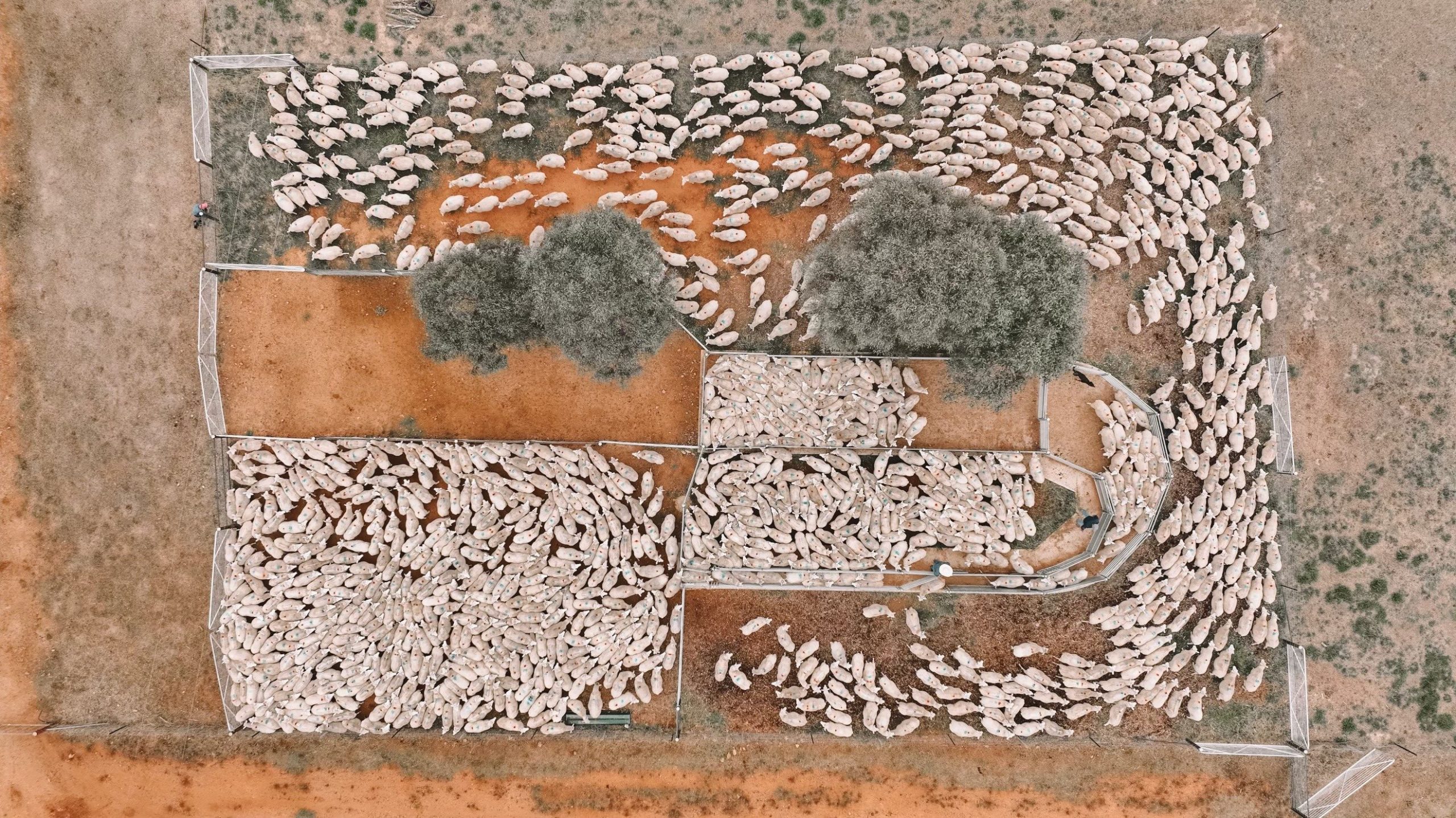
Multiple Livestock/Supply Chain Positions Available
LAMBPRO is a leading sheep seedstock business based at Holbrook NSW. The business is one of Australia’s largest seedstock businesses, with over 11,000 fully recorded seedstock ewes lambing down in 2023. The business has a long record of innovation in the sheep genetics and meat industry. LAMBPRO also operates a lamb export business, exporting clients lamb to several countries.
We are searching for friendly, passionate young people, who want a career in the sheep and/or meat industry. You will start with the sheep and genetics part of the business with supply chain activities for the first year, with the opportunity to branch out into specific areas of the LAMBPRO business. LAMBPRO, a rapidly growing business, offers opportunities for young people wanting to progress into farm operations, genetics, or meat and supply chain roles.
We have accommodation on farm, with the property located less than 10 minutes from Holbrook and 45 minutes from Wagga and Albury. Remuneration will be based on education and experience. These jobs will be applicable to applicants who are graduates, school leavers, or young people currently working in the industry.
Please send resumes to Tom Bull [email protected]
Volatile Markets: The Norm in Food Production
VUCA
Volatile Uncertain Chaotic Ambiguous
When VISY Chairman Anthony Pratt addressed the Global Food Forum in Melbourne in May (2022) he had a very simple theme for anyone in the global food supply chain, be prepared for a ‘V.U.C.A’ world.
The past six months have highlighted the reality of a VUCA world. The invasion of the Ukraine by Russia has seen the geopolitical influence on world food prices become a reality, heat waves in the Northern Hemisphere, chronic labour shortage in food processing, and the threat of Foot and Mouth Disease. All these factors are currently impacting Australian producers at present.
This volatility will always be ongoing and has been a constant over the past few decades. From volatility comes opportunity and we need to be agile to position ourselves in a fast moving world.

Why Low Cost of Production is KEY to a VUCA World…
Cost of production is the lost metric of lamb production. For many new age consultants, it has become ‘rear vision metrics’, and many changed the drivers of lamb production. Production in lamb is a lucrative focus, with lambing percentage, lamb survival, condition score, and food on offer becoming the normal points of discussion among many lamb producers. While not discounting many of the benefits a focus on these points brought to lamb production, many were driving cost of production up, not down.
Leading producers can produce lamb under $4kg dressed weight. This allows significant volatility in end market price and these low cost producers can still make money. From my experience, simple low cost systems with clear production goals win every time in lamb production. When taking advice, question its relevance to cost of production, as opposed to simply production.
This article was originally published in the 2022 LAMBPRO Newsletter.
PRIMELINE MATERNAL EWE SALE
Thursday 24TH November 12PM, AUCTIONSPLUS, 3,500 EWES
TASMANIAN PRIMELINE MATERNAL SALE
The Tasmanian Primeline Maternal Sale will be held on Wednesday 11th december 2013, 4pm at the Happy Chef Cafe, 3 William Street Longford. The catalogue is available here.
Hello world!
Welcome to WordPress. This is your first post. Edit or delete it, then start blogging!

